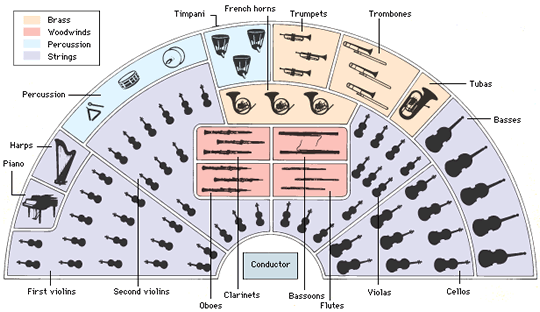
By Ashok Boghani
Different instruments
Now on to different instruments involved in WCM I will mainly deal with a symphony orchestra, because that’s where most instruments are deployed. As we will see, other types of music can be performed with fewer instruments, including many with just one.
The image below shows different instruments and how the players sit in an orchestra. You should note that the instruments are classified in four groups, brass, woodwinds, percussion and strings.
Note that in most cases more than one instrument is deployed. There are two reasons for doing that: (1) multiple instruments playing the tune create a marvelously rich sound and (2) they create louder sound than that produced by a single instrument, which was important in the days before amplification was invented.
The string sections are the backbone of the orchestra. They have four types of instruments—the largest, and the ones with the deepest sound are called double basses. Then, going smaller, you have cellos, violas and violins.
The woodwinds are oboes, clarinets, bassoons and flutes. They provided deeper colors to the composer’s pallet. The brass group, which provides light, shimmering colors, is composed of trumpets, trombones, tubas and French horns. Finally, assorted drums and other instruments that make sound when hit, are all members of the percussion group. As I had mentioned before, unlike in the case of ICM, one can get rhythm without using percussion instruments in WCM. That having been said, listen to the power of percussion in this popular piece of music written by Richard Strauss.
Listen to the brass section introducing the theme followed by the strings. It is however, the percussion of a kettledrum and cymbals that carry this memorable composition that featured in the film 2001: A Space Odyssey. No need to listen to the whole thing, just the first two minutes.
OK, back to the instruments.
Listen to this “Young Person’s Guide to the Orchestra” written by Benjamin Britten in 1945, based on music composed by another British composer, Henry Purcell. It is a little long but it shows what each instrument sounds and how together they create beautiful music.














It would be good to define why you refer to a piano as a string instrument when it is percussive. A simplification would be to classify it as a keyboard. Appropriately stated as a cordaphone. Would you agree?
Good point. It has strings that are hit by a hammer, so one can classify it in other manners. No my decision 😉
As long as one enjoys the instrument, it does not matter a lot how it is classified.
It would be good to define why you refer to a piano as a string instrument when it is percussive. A simplification would be to classify it as a keyboard. Appropriately stated as a chordophone. Would you agree?